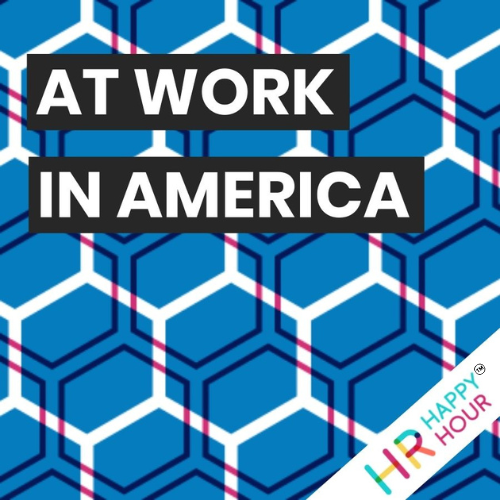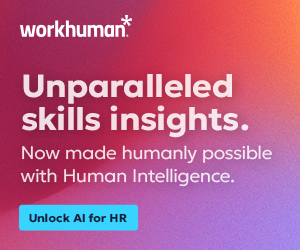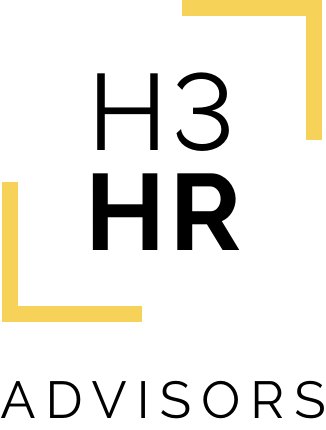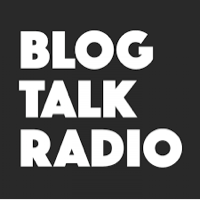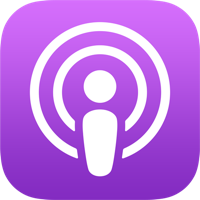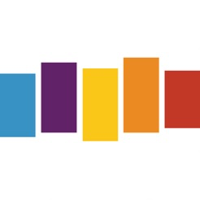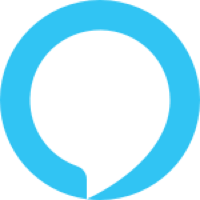Evaluating and Adopting Innovative HR Technology
Hosted by

Steve Boese
Co-Founder and Chief Data Officer of H3 HR Advisors and Program Chair, HR Technology Conference

Trish Steed
Co- Founder and Chief Strategy Officer, H3 HR Advisors
About this episode
Evaluating and Adopting Innovative HR Technology
Hosts: Steve Boese & Trish Steed
Guests: Don Weinstein, Strategic advisor, Venture investor and Corporate board member
Today, Steve and Trish met with Don Weinstein to discuss innovations in HR technology and the importance of AI, particularly in recruiting, learning, and help desk management.
– The importance of AI in HR
– Current state of HR technology innovation
– Challenges and strategies for HR leaders
– Innovative companies in the benefits space
– Employee-centric solutions
Learn more about the companies we discussed today: paid Nayya Summer
Thank you for your continued support of the show and subscribe wherever you get your podcasts!
This episode of At Work in America is sponsored by Paychex. Join Beaumont Vance, Paychex senior vice president of data, analytics, and AI, in an exclusive on-demand webinar, to discover how leaders are using AI to streamline HR tasks and supercharge efficiencies. You’ll learn how to automate those tedious tasks and free up your time for what really matters — your people. Don’t miss this opportunity to learn from an industry leader. Visit paychex.com/awia.
Transcript follows:
Announcer 0:00
Welcome to At Work in America, sponsored by Paychex. At Work in America digs in behind the headlines and trends to the stories of real people making a difference in the world of work. And now here are your hosts, Steve Boese and Trish Steed.
Steve 0:28
Welcome to the At Work in America show. My name’s Steve Boese. I’m joined by Trish Steed. Trish, what is happening?
Trish 0:34
Not a whole lot today. It’s midweek, and I’m just trying to get through it. How about you?
Steve 0:39
I’m well, we’re grinding down the last week of unofficial summer next that’s right weekend coming up as we record. This is Labor Day weekend, and got a great show coming up, though, so I do want folks to take at least some of their time over the next couple of weeks and spend some time with our guest. We have Don Weinstein, who’s longtime guest, friend of the show, digging deep into HR tech innovation advice for HR leaders and plenty more. It’s great, great conversation.
Trish 1:10
And you know what? He is so good that we’re going to be bringing him back once a quarter to give some information about, you know, companies to invest in, companies to be paying attention to and so he’s going to drop a few of those on this episode. And so have your pen and paper ready, or your your device ready to record some of these good tips he’s going to share.
Steve 1:31
Absolutely. And he talks a little bit about voluntary benefits, oddly enough, right towards the end of the show. And I do want to say congratulations to our friends and show sponsor Paychex, Trish, who have won one of the Top HR products of the Year awards for the Paychex Flex Perks product, which is the voluntary benefits platform that they’ve made available to their customers. And so you can learn more about that. But thanks to Paychex, of course, for sponsoring today’s show, there’s some great resources that Paychex always makes available to our listeners, Trish, and now you can go to Paychex.com/awia to get access to a webinar by from Beaumont Vance, who’s Paychex Senior Vice President of data analytics, and AI, a webinar to Discover how leaders are using AI, right?
Steve 2:22
This is the age of AI is Don talks, yeah, show coming up. But to look how, to look how you could streamline HR tasks, supercharge productivity and efficiencies, automate tedious tasks and plenty more, Paychex is embracing AI and but they’re not just embracing AI. They’re providing resources and tools to help you understand it and get the most out of it. So go to Paychex com, awia, and check that out. And then, of course, congratulations, and thanks again to our friends at Paychex.
Trish 2:51
And you know, what can I just say? They are always, like, two or three or 10 steps ahead of where everybody else is, like, they are so good, and then they share that knowledge. So What perfect timing too, is we’re going into the big fall conference season for HR leaders to learn more about data and AI. This is on everybody’s minds. So again, Paychex just gets it out there and is topical and before everyone else.
Steve 3:17
Yeah, so we’re leaning into HR tech a little bit these next few weeks and months. So hope you’re enjoying that and along for the ride, enjoy the show coming up with Don and thanks for listening to the show today.
Steve 3:40
Trish, we are excited today to welcome our guest, a repeat guest, a frequent guest, friend of the show. He is Don Weinstein. He is a strategic advisor, venture investor and a corporate board member. You might know him previously as ADPs global chief product and technology officer, where he was responsible for all aspects of ADPs global technology strategy and delivery, where he successfully introduced numerous new products and industry first, including the hugely successful ADP mobile app, the ADP marketplace, the ADP Data Cloud, among many others. Don Welcome back to the show. Great to see you.
Don Weinstein 4:18
Wow. Thank you. With intros like that. You can just keep me coming back time and time.
Steve 4:22
It is quite a bio, but an impressive one as well. And we talked a little bit in the opening about how the top products of the year kind of thing just happened. And you know, I was involved in that for HR tech again. And during your tenure at ADP, Don, it was year after year after year. ADP was winning that award for just innovation after it must have been five, six times in a row. And I know you had a big team that work helped you do all those things, but you certainly played a big role in that. So yeah, it’s impressive. And you guys had, she had a run there that was really phenomenal. Thank you.
Don Weinstein 4:58
Technically, it was eight years in all, but you know, I’ll tell you
Trish 5:03
The interesting thing was, I didn’t meet you. I don’t think until I probably near the end of being a practitioner, but in my entire career, it was all in St Louis, and no matter where I worked, we had ADP. So I was actually benefiting from all of this hard work that you were doing over the years, you and the team from a practitioner standpoint. So, yeah, I can attest the things that we were using were great and always, always kept us ahead of things. So and as a you need to be like a co host. Can we make him an honorary co host?
Steve 5:33
I feel like he’s might as well be, yeah,
Trish 5:36
anytime.
Steve 5:37
I think probably our most frequent guests over the years, I we counted them all up. I think probably, yeah, yeah,
Don Weinstein 5:44
wow. It’s like Shark Tank. When they have guest hosts come in.
Trish 5:49
Yes, you’re it, you’re we deem you that right now, there you go. And you’re like, your 10th show or something.
Steve 5:55
So folks who listen to the show might have caught Don along with a few other folks a few weeks ago when we were doing some 15th anniversary celebration shows, and we had Don on with a few other great folks like Cecile and Lisa Sterling. I’m forgetting some people. Mike Harden was on with us, and a couple of other folks, Meg and Gretchen, yeah, Gretchen and Meg Bear, right. Great. It was a really good show. It’s in the archive on hrhappy air.net, but during the show, I alluded to a story I was going to tell about some ADP stuff back in the day when Don was still there, but the we just ran out of time for the story, and it didn’t really make sense for that show. It’s in my notes Trish to tell the story, right? Because I mentioned it again. And I’ll tell the story. I hope it’s as funny as I remember. It. Maybe one of those stories that’s only funny to me, and there’s a little bit of kind of inside HR techie baseball going on too. So I’m guessing on the year, let’s call it 2015, 2016, or so. It doesn’t matter, but it was in that that time frame, a new company popped into the HR tech landscape called Zenefits, and it might have been 2014, maybe, I don’t know, it was a while back.
Steve 7:09
So that was the company, and some people might remember them. They are still around in one form or another, I believe. But they had entered the HR tech market and made a lot of noise, right? They had some innovative new technology. They had a very aggressive business model, as it turns out, some questionable business practices we learned later on. But they they were making waves in HR tech. And since we were doing the HR tech conference, of course, right the biggest event of the year for HR technology, of course, I was interested in having, having them be a part of that. At the time, they’d raised a ton of money to, I guess, they might have been unicorn status at that point. And so their CEO and founder was a guy named Parker Conrad, who is still around in HR tech, by the way, and having a kind of a remarkable second act with a company called rippling, but that’s, that’s another story. But Parker was an interesting guy. There is a podcast you weren’t on it for whatever reason. I don’t think you really particularly liked Parker.
Trish 8:12
I did not care for I see, I pick up vibes. Let me just tell you what. And I knew the second I met that man. I was like, nope, nope. Yeah. Not afraid, not afraid to say it. So I wouldn’t know I didn’t appear on the show.
Steve 8:26
There is an HR Happy Hour Back in the archive with me and Parker back from the Zenefits days, which was interesting conversation. And after that, I said, Hey, Parker, you should really come to HR tech and participate, you know, do a panel with me, etc, etc, meanwhile, and I don’t remember the nuts and bolts of it, and bolts of it, and it doesn’t really matter anymore. ADP, the biggest, really HR, tech company there is, right? Got involved in a lawsuit with Zenefits, and I can’t remember now who sued whom, or maybe that was a double reverse lawsuit. Maybe both were suing each other, I don’t know, but that was going on at the time, right? And so we were doing this panel, HR tech, in the middle of these lawsuits, and, you know, these panels are just, they’re just panels. They’re not that big a deal. And I was getting, I was going to moderate this panel, and it wasn’t even like in the big room or anything. It was like a side room or something. And we get to the panel, and people start coming into it, and it was like, you know, a couple of vendors, maybe workday was there, and I got Parker to do it, and maybe someone from Oracle. I don’t even remember who else was there. And all of a sudden I see in the front row a couple of folks from ADP who I knew, who worked for ADP, like big, big hitters, Don I don’t specifically remember if you were there or not, but it was there, okay, who’s executive types.
Steve 9:42
Next thing I know, I see Carlos in the in the audience. Carlos, who is the CEO of ADP, the most powerful CEO in HR tech, super wonderful person, by the way. I loved Carlos. He’s retired now, and you know, Godspeed to Carlos, wonderful guy. But. He was sitting right in front, like the second row, dead center to listen to this. And basically I felt like the whole ADP team was all lined up in the second row, staring daggers at like Parker, maybe me too. I don’t even know they were Yes, and I just thought it was hysterical, because Carlos, look, he was such a wonderful guy. But at an event like HR tech, you know, you’re not going to get five minutes with him. He’s going to be with customers and investors and whatever he’s doing, right and and for him to take an hour out of his day, along with most of the executive team or whoever was there, and Don included, to sit there and watch this. I thought was really funny. So that’s that’s the story. I thought it was hysterical, and I don’t even remember a word of anything anybody said at the panel, either, but I remember, like the ADP team just laser focused on what was going on, you know, with the with the with Parker from side effects. So that was the story, and it was funny to me. So thank you for indulging retelling it.
Don Weinstein 10:59
It was it was fun. I remember I was there. I know exactly what you’re talking about, but I think, I think Trish nailed it, though she’s got the, she’s got the people instincts there. And, you know, Carlos is the, the most, highest integrity individual I think I’ve ever met and certainly worked for in my life. And then, you know, not everybody is held up, holds themselves to that same standard. And that’s, that’s all I want to say about that.
Steve 11:23
Yeah. And what’s developed subsequent to all that is complicated and boring, probably, to the ripping stories, is interesting now, and maybe someday, Trish, I’ll coax you into talking to Parker again, but the that’s the story.
Don Weinstein 11:39
So that’s a hard no from Trish.
Trish 11:41
No, you know what? I think I won’t get into him personally. I would just say, like, kind of what we’re going to be talking with Don about today, when we’re talking about investing in new companies and new technology. I think integrity needs to be front and center when you’re talking with anyone, especially of a startup or something you’re going to invest money in. And you do have to go a little bit on your gut. I didn’t have a specific reason. I mean, I remember going to an analyst day, and I was just like, hard, hard, stop, nope, nope, nope, nope. I didn’t know why. You know what I mean, but sometimes you have to listen to those little Inklings. And I know Don as we kind of talk through today’s topics, I’m sure there’s some of that that goes on with you, right? Just from being a very experienced, seasoned executive, you do have to listen to that little voice in your head saying, not so sure about this. One might be cool, but might not be the right the right thing, right now, right?
Don Weinstein 12:33
100% very important. You want to know who you’re getting into you know who you’re getting into bed with, so to speak, for sure, yeah.
Trish 12:40
It does reflect on your own brand. And I think, and again, there can be very nice people in any industry, but there they are also people who are not on brand with what you are trying to portray and hold yourself to that high standard. So yeah, that was all that was. There you go.
Steve 12:56
All right. Well, no, enough of a trip down memory lane. Let’s talk about what’s happening now, like Don we mentioned, of course, in your bio, you know, Chief Product Officer at ADP for a long time, lots of innovation. Now you’re working with startups, you’re investing you’re sort of still really got your hands in the space, but now you’re getting to really stay, like, kind of pick and choose what you’re interested in and what you want to do. I’d love to get your thoughts on just where innovation is happening right now, in HR and in workplace tech. What’s interesting to you? Maybe give us a couple of thoughts on on where we’re at right now in 2024.
Don Weinstein 13:32
Yeah, no, we’d love to and, and thank you for the for the opportunity. I mean, clearly right now, all the energy is in, is in AI and artificial intelligence, and that includes a heavy focus of venture investment. And whenever you see that happening, that becomes kind of like a self fulfilling prophecy, because all that investment, well, first of all, it attracts investors, and the all that adventure investment attracts founders and attracts engineering talent, and it just becomes a critical mass in and of itself, and and then domain like, like human resources, I think some of the use cases look look pretty promising. Certainly, there’s been some early traction in areas like recruiting, using AI to help candidates match with potential openings in learning to chart out learning development paths, even mundane stuff like Help Desk and case management. But at the same time, I think there are a few Watch out areas to be mindful of.
Don Weinstein 14:34
And it happens typically whenever a new technology gets introduced and everybody gets excited about the promise and the potential, but, you know, you miss out on, you know, what are some of the spillover effects? I’ll just give you a couple things that kind of, I’m I’m seeing right now. And for example, let me use an example from from kind of my world on the technology, and think about one of the hottest use case out there. Is a. AI driven programming, right? So people are using AI to generate code, and again, it looks really promising. There’s lots of productivity documented productivity benefits for it. Every single one of the startups I’m working with is doing it. But here’s an interesting kind of side or effect, like, what happens when there’s a bug in the code that was generated by the AI who’s going to debug? Have you ever tried, Steve, I know in your prior world, have you ever tried to debug somebody else’s code?
Steve 15:31
Yeah, wait a long time ago, awful. Yeah, it’s brutal.
Don Weinstein 15:36
So who’s going to debug the who’s going to debug the AI generated code? Another AI now you have one AI agent debugging the other. AI agents code. It becomes a little a little wonky out there. You know, the second thing I would say is, just again, the dirty secret in our in our industry, is, is the data. And I think hrhappyhour net data is some of the least reliable data that there is out there for a variety of reasons. So one of the things I look at is both inside an organization, but also, if I’m looking at potential technology vendors, everybody likes to talk about their data science team. Talk to me about the data engineering team. How big is it? You know, are they? Are they who’s cleansing the data, who’s organizing it, who’s managing it? You know, when, back when, when I was at ADP and we were building the Data Cloud, I want to say we had about 10 data engineers, maybe, maybe five, at least, for every data scientist and, and that’s not a bad thing, right? Because, you know, five great data engineers can, can make a data scientist enormously valuable. But if you’re just dropping a data scientist on top of a of a messy data set, you know, the algorithms are only going to be as good as the underlying data they’re running on.
Don Weinstein 16:54
So and then, you know, a third thing that it just to me, it feels like we’re still in the very early phases of this, and I could see it unfolding almost similar to maybe I’ll use the mobile revolution as an example, where mobile came out, it hit the scene. And what did everybody do? Step one, take your existing process and adapt it to mobile. But by their nature, these existing processes didn’t grow up in the mobile era, so they didn’t really take to them. Step two, we started to call it like mobile first, right, which was more of like the hybrid or the halfway house. Well, let’s start with a mobile framework, but let’s, you know, then let’s kind of go backwards and try and make it backwards compatible to a desktop interface. And often you’d end up with deprecated functionality, and you know, then finally, in phase three, we’re like, Okay, let’s stop doing that, and let’s just rethink the whole experience from from the ground up. And so I see a lot of Technology Paradigms going through those, those phases, and I think we’re starting down that path right now with leveraging, you know, generative AI inside of HR practices. But it’s clear we’re still in the early stages of phase one. And you know, it’d be great if one of these days we could, you know, we do the same pattern every single time. If one of these days, we could take a step back, accelerate our way through step one, skip step two, and let’s just get step straight to step three, and actually, let’s just really rethink things from the ground up, but for whatever reason, that never seems to happen.
Trish 18:28
Well, you know what? I’m glad so two things. First of all, thank you for pointing out about data engineering. Because I’m sitting there thinking like, if I have my HR hat on, or maybe I’m another C suite leader who I’m not sure where my focus and my questions need to be. I think that was a very valuable one. So absolutely take notes on that if you’re listening. But secondly, I would say, Don I think that even being back in, you know, corporate world, for example, there’s a lot of times where even the HR leader might be pushing for, you know, certain process changes before you go through a big technology, you know, purchase or deal, and it’s often the other business leaders are like, no, no, I still want to see my report the way I’ve seen it the last 20 years, right? So part of it has to be pushed on the C suite leaders to say, look, we need to agree to do something different. We need to be open to it. And I think that’s a little bit of where the disconnect is, because who’s in charge of making people even open to process changes.
Trish 19:29
Otherwise, you are still going to have that no matter what, whether it’s AI or mobile or whatever. You have to be really careful. I think when you’re talking to a CFO or a CEO or COO and say, Look, we’re gonna just take a leap of faith here. We’re gonna really change up the way we do things to have more productivity and effectiveness. But I don’t know, the places I worked tended to be the opposite. And again, I was an ADP customer at many places, but you know, it was frustrating to be in HR and thinking. Oh my gosh. We have all these great capabilities. We can’t take advantage of them. What do you tell if you’re an HR leader or someone listening now, what do you tell them? Like, how do you have that conversation with your fellow C suite members to impress upon them the urgency and the need for process change as part of maybe new technology selection and implementation?
Don Weinstein 20:21
Yeah, no, you’re right. Technologies change, but people don’t. And so we see those same behavior patterns. The other common behavior, like, what I would often do, is, the other behavior pattern you’ll see is, is there’s always the distribution of people between the kind of the early adopters, the mainstreamers and the laggards. And so one of the things I used to do was, was let me find within the C suite who’s going to be my, my partner on this one, who’s somebody who’s excited about it. I would do that both internal, as a consumer of technology, and find who’s my internal partner, who’s really going to be that, that lighthouse. I would do that on the external side too. It’s like, you know, we had a humongous sales force, well known for it, but within that group, there were a handful of people who were really just excited about the new technologies. And to me, it was always, let me find that person who’s going to be, you know, more of the leading adopter who I can partner with. And then we use the term, we use the term lighthouse project. Let’s do that lighthouse deployment here, and then we can showcase it back to the rest of the organization as a way to to spur it on. But, you know, human behavior wise, it’s, it’s hard to imagine, you know, you’re going to be able to get everybody to adopt right out of the gate and change their processes right away. So just find the, you know, path of least resistance, I would say, and, and try and focus there, and, and, you know, the internal proof point was going to be worth 10x 100x whatever external case studies you can you can bring in, yeah, the other thing we would do.
Trish 21:52
Knowing that that’s really good, because I wouldn’t have thought to maybe even ask the vendor you’re going to partner with, right say, look, I’ve got a kind of a tough group here. I need your, like, your best person at really being optimistic about this and showing the value up front, right?
Don Weinstein 22:05
That’s right. That’s right. Absolutely good tip.
Steve 22:09
Don I mean, we did go ahead. I’m sorry, sorry.
Don Weinstein 22:11
I wanted to. I mean, one of the other things that we, that we did, is it was always super effective. Was same thing going back to the vendor, and we would do site visits in particular, and ask them, find, find me one of your current customers who looks like, roughly speaking, what we do, and is willing to talk and host us. And there are a number of times where we took the entire executive team on the road and would do, spend a half a day or a day with one of the customers of the, you know, of the other company. Now, again, we were we were big. We were big company. We had a lot of joint customers. We spent some money. So we were able to kind of throw our weight around a little bit like that. Sometimes that maybe doesn’t work for everybody, but when you can, I think it’s a wonderful way to get you know your executive team all seeing the same thing at the same time and out of their day to day context.
Trish 23:11
Oh, I like that.
Steve 23:13
Yeah, I remember, God, I’m not going to tell another long story, but God, I’ve got some great stories of site visits back in the day when I was part of a software selection team for a very, very big company. I was working for it, but it was so valuable going around. And we toured, we probably did six or eight of them right over the course of the year, you know, we were about to make like a, what ended up being like $100 million purchase or something like that, right? And so it was definitely, definitely worth it? Don I think so. Site visits and doing those deep dives into customer references is certainly one way that organizations can better evaluate technology. But maybe let’s step back just a half step and sort of say, what are some advice you have to for HR leaders or organizational leaders to try to assess technology a little bit more generally, like we’re going to go to HR tech in a few weeks. And lots of other events happened this fall, and there’s this, this wave of AI solutions and other innovations coming in the market. The market’s very vibrant. Still. Lots of money coming in, as you suggested. Don for HR leaders, I feel like we’ve been talking about this for 15 years, but it’s still probably true, like, what are some tips or guidelines to help them better assess this market and understand where to even devote some of their attention first and then, potentially their resources next?
Don Weinstein 24:34
Yeah, no, for sure, I think it’s challenging right now, with so much coming at you, and I know in my old role I was, I was a big buyer of technology, so I can empathize, you know, just getting pounded by by various offers and value props out there. And, you know, look, a few things I would, I would recommend, the first one is, when you’re looking at at solutions in general, but especially AI solutions. I. Yeah, definitely include your your CIO and your CISO early in the process. I know that sounds a little self serving, coming from where I’m coming from, but they can be real assets in helping you to understand the underlying technology. Cut through some of the vendor jargon, and again, if it is an AI based solution, you want someone who can really probe the quality of the underlying data, the algorithms, the quality of the engineers who are building the solution set, and not just get caught up in the slickness of the UI itself. It’s definitely something I would do if you are getting a demo, and generally you should. I always like to take the demo team off their script, right? Everybody comes in, they’ve got their demo script. They’ve got their happy path, you know, the best ones.
Don Weinstein 25:50
And in having been on both sides of the equation, you know, I also respect it. If I’m in a, you know, if I’m in a buying situation, I don’t want to hear your canned demo. I want to ask my questions. If I’m in a selling situation, I would always respect it when a customer told me, here’s what I’m interested in, here’s what I want to see. And I’ve had really good processes which they would tell me, Hey, you’re going to come in and do a demo, and I want these are the 20 use cases that I want to see. I don’t care what your, you know, demo environment does, but I’d also like to throw them curveballs from time to time, just to, you know, just to test, all right, how, how robust is this environment? You know, are you just giving me all that, the kind of pre canned, happy path type of stuff? Yeah. But then, you know, the most important thing that I would always if I was making a large scale decision along the line, Steve, of what you, you described, is, I always did either a POC or even a small scale pilot with very rigorous performance targets. Now look, that makes things harder for the vendors, right? They really don’t want to do it. The flip side is, if they really believe in what they’re doing, they should be willing to sign up for it again, especially for a big person purchase. It’s also going to tell you a lot about how hard or easy it’s going to be to deploy that solution, right? Like if you can’t get a POC stood up rather quickly. What do you think that enterprise wide deployment is going to look like if you can’t get them to agree to do a POC or a pilot before going live. How confident are they in their ability to drive real, measurable results? So you know, you’re not going to do it for maybe for smaller things, but any kind of like big ticket item never bought anything without at least a P A live POC in my environment.
Trish 27:43
So many good tips. I feel like you need to write a book, but on the horizon, please tell me it is. No, I say it kind of laughing, but it’s true. I think when you go through, you know, you sort of grow up in human resources. You’re not ever taught how to buy technology. You have to do a lot of learning on your own. And so a lot of these tips you’re giving are, you know, it’s not just common sense. These are things you have to learn through experience. And I love the idea, though, of bringing you know that the chief technology officers, chief, you know, information officer in early because I think in HR, sometimes we’re, we’re a little nervous about what we don’t understand, like we might be exposed that we don’t understand it all, but really that’s your chance to be a learner yourself, right? And people are more bought in when you’re doing it together to begin with, yeah, I think you know for sure what I mean.
Don Weinstein 28:32
Tthe SaaS the SaaS revolution, really transformed the the enterprise technology buying process, right? It went from being everything was on lockdown to kind of the wild wild west. So one of the things that we did was we created this, whatever you want to call we called the software Advisory Council. But effectively what we did is we paired and partnered. Usually it was like one, maybe one or two functional leaders, like in the HR domain, it’d be like your HR tech leader who worked oftentimes would be someone in the HR function with somebody in the CIO office, like a two in the box model, and their job was, was not just on the evaluation side, but to be proactive, right? So that we’re not kind of, because if you’re not proactive, I mean, you think about nobody imagines themselves in this box, but you’re basically getting pulled around by the vendors. And I don’t mean that in a negative sense, but they’re pulling you in certain directions, as opposed to you going through, okay, proactively. Here’s what we think we’re we need to do. Here’s what our organization is going to look like in the future. Let’s put together a proactive roadmap of all the technologies we think we need, and then proactively start going out there and evaluating them. And so to that point, if I’m going to a show like an HR Tech, I will have already, you know, got my, you know, my long term vision of where I want to be from a human capital management perspective, to. Opportunities and gaps I need to suss out. Here’s my short list of domain areas vendors I want to go look at, and then let me take my my HR subject matter domain expert and the person I’ve paired them up with in the CIO office, and let’s go and we’re proactively defining our technology roadmap, versus just reacting to all the vendor pull that’s, that’s out there.
Steve 30:25
Yeah, that’s, that’s outstanding advice, and really great advice, and timely advice. As we approach this fall season, where there’s lots of market information coming, there’s lots of conferences, there’s, I mean, virtual and in person conferences all around the world, honestly, in the HR tech domain, and so we’re organizations to really, and they’re thinking about also, right? Like heading into the fall, planning on budgets for 2025 if companies are doing in a calendar based budget depending on your fiscal year, things like that, right? It’s a great time to approach this very strategically. And as you said, Don you lead the conversation rather than being led around right by the next fancy tool. Don one of the things we wanted to talk to you, with you about, and just since we said at the beginning, you’re able to pick and choose your areas where you want to work in. You want to spend your time in, what’s interesting to you, etc, etc. Maybe there’s a couple of either just types of technology or specific solutions, one that you are really intrigued by and you may be working with. Now that’s fine, you know. Just tell us like, boy, this is really interesting and exciting. And let me tell you why, because from your experience and perspective, it matters more, I think then, from most I’d love for you to maybe share a couple of, a couple of really tidbits for our audience that things to look out for.
Don Weinstein 31:48
Yeah, no. Appreciate the the opportunity. And you know, the area that I’ve been most excited and passionate about since, since moving into the new space that I’m in, it’s really all around employee centric solutions and just I’ll put the broad category of employee health and wellness and welfare together, and what can it was an area we were we were pushing down that path when, when I was at ADP, we just got more and more interested in understanding who is the ultimate, ultimate customer, Who is the ultimate user of the solution. And you know, from an altruistic perspective, how can we help make their lives better? I, by the way, I certainly have a newfound passion for it. As I’ve got two kids now who are in the workforce, and I see their trials and tribulations. I know how challenging it can be out there. I really experienced the workforce through their eyes. You know, the true Gen Z ers in the workplace. And so a few areas, you know, a few areas I’m excited about, you know, one is I talked a little bit about about financial wellness.
Don Weinstein 32:57
You know, it’s popular now, given some of the challenging economic landscape that we see out there. But look, we’ve been through challenging periods in the past. That’s not new. I think what’s new is employees willingness to take the help from their employers. I think previous generations, certainly my generation, might have had more privacy and other concerns to want to keep that in arm’s length, but you know, the generation the workplace right now is much more open to having, you know, that conversation could be with, you know, technology vendor could be via their employer route. So, you know, I think the flip side of that is there’s just, it’s almost like there’s too many solutions coming at the individual employee, and so they have a hard time figuring out how to make use of what’s offered. So, you know, we were pushed. I mentioned we were pushing down this path when I was at at ADP, we had launched our wisely platform for people to get paid and then use that as a vehicle to start to layer in these additional solutions. So capturing people at the point of pay, maybe showing them things that they’re interested in, like, maybe it’s early pay, earned wage, access, savings, incentives and rewards, and then using that as a way to start them down the path of financial wellness. So, you know, one of the companies I’ve seen out there that’s doing this, you know, kind of new, exciting, is a company called paid, it’s at Hellopaid.com and I think what’s, what’s key about that is, rather than being a point solution provider, you know, they’re trying to look at it holistically, but also, you know, here are your discounts, here’s your earned wage access, here’s your other award. Let me take a look at this holistically, but then try and capture people at the point of pay so you can sort of get their attention, which is something that that obviously ADP had pursued, I think, quite effectively. And then another example of that now I’m going to talk about in the health space, and in particular with ancillary benefits. So what’s interesting to me is the sheer number in. Nature of Employee Benefits and categories. It’s just exploded, right? It used to be a health, dental, vision, maybe a little life insurance. Now we’ve got pet insurance, long term care insurance, and then hospital indemnity, legal indemnity. The list is, is endless, and yet, if you identity
Steve 35:18
Theft is another identity.
Don Weinstein 35:21
I saw a statistic. There eight now 88 categories, not companies, categories of employer sponsored benefits. And yet, if you ask the average employee if they’re satisfied with their benefits, or even they understand their options, most of them will say no. They’re confused. And it’s a shame when you think about how much companies invest here, right? So that the data point I have is us, companies are going to spend about $3.3 trillion on employee benefits this year, trillion with a T. And by the way, that amount is growing twice as fast as cash based compensation, because there’s some, you know, tax based benefits to paying benefits as opposed to salaries, right? So we’re paying more and more benefits, and yet, as much as we’re paying more benefits, out, employees are more confused and less satisfied. And so here again, we need a way to cut through the noise, help them understand it, but do so in a manner that’s more employee centric, as opposed to, you know, vendor solution centric, because every, every vendor is pushing their, you know, their ideas, right? Well, hey, we’ve got an HSA account. We’ve got a four oh and and, apropos of nothing else, in the abstract, they may make sense, but everybody’s got different needs, different circumstances, different preferences. So one of the innovative companies that’s really way out front here is called Nia, with two wise and they’ve built an intelligence layer that sits on top of all these offerings and takes into consideration the individual. Now we’re leveraging AI, which we can to personalize recommendations based on each individual’s unique needs and preferences, right?
Don Weinstein 37:06
So, you know, should I top up my 401 K account? Should I put more money into my HSA? Should I pay down my student loan debt? It’s going to vary. You just can’t look at these things in the abstract, and so it’s just a really better way to help employees make decisions about their benefits and use them throughout the year like I was. I was given the personal story so my oldest daughter, she just turned 26 right? So congratulations, you came off of my health plan. I told her, You’re now officially an adult, right? You’ve got your own health plan. You’re paying your bills, you’re making your own you’re making your own appointments. Wow. Like, I can’t even make it, wow. You’re, you’re an adult now, but so when she got so, she turns 26 and she’s got a, really, you know, she works for a good company. They have good benefits, but she’s never, you know, she’s always been, you know, part of my plan. So they sent her a 40 page PDF. Here you go. Have a read. And, you know, open enrollment, pick what you want. She just takes one look at it. And of course, Dad, what do I do? And, okay, I think I’m in a position where I can give her good advice. So like, she’s young, she’s healthy, she’s 26 I said, you know, you need, you should be in that high deductible plan with an HSA, right? And again, based on her specific circumstances, but pattern that’s going to be for for most people. And she said, but all my friends are signing up for this plan with the FSA account. Oh no, I could help them so much. It’s, it’s, it’s, so that’s what, basically, you know, Naya is, it’s, it’s your personal benefits co pilot out there. And, you know, another great factoid I saw as the in, you know, health plan. Now I’ll use the family number for an individual, it’s going to be lower, but I think a family plan costs about 20, roughly $20,000 a year, and then the employee share is going to be, typically, 30% so $6,000 the average person will be spent more time picking out which color TV to buy, which flat screen, then on their health insurance. And people get you overwhelm them with with with information. They get confused, they tune out, they take the default option, and they need help. And that’s what, yeah, that’s a really great point.
Steve 39:19
Don, then there’s been some innovation there, and there’s been some advancements there, like, but, but it’s been a little bit narrow and not taking the bigger picture into account. Like, there are some tools we’ve seen them, right, that help an employee. Well, how many times do you think you’re going to go to the doctor? Oh, seven times, yeah. What prescriptions are you taking? You know, it’ll help them direct them a little bit. But it doesn’t kind of take other aspects of your life, right?
Don Weinstein 39:46
Yeah, I mean about taking example, like funding an HSA account in the abstract, sounds like a great idea, right? Okay, but do you have student loan debt? Do you have credit card debt? Where are you and all that stuff? Maybe it’s not a great idea. And. And that’s the problem with all these other tools that are just kind of very sort of narrow in their scope. And I think that’s where Naya really differentiates itself by being, you know, the the most holistic out there. Could I throw? Could I throw one more? Yeah, go ahead, please. Yeah. So, so there’s a company I’ve been working with that that I really love as well, called Summer, and they’re in the student loan benefit space. And so we’ll start with the factoid, total student loan debt outstanding right now is $1.7 trillion total student you got mortgage, credit card, student loan, I think, is the number three category of debt. It’s a real problem. And I know a lot of young people who are who are struggling with it, people I had a conversation with a friend recently and and their kids are like, well, they want to get married, but, you know, they can’t afford to move out of the basement because they’ve got this true story. You know, it’s sad. So what I love about about summer and what they do, is they help individuals navigate the student loan space. But they really started out from the perspective of forgiveness, because they’re all these government programs out there, you know, you read about it in Oh, the government is going to forgive another $500 billion of student loan debt.
Don Weinstein 41:25
Sounds great, that’s the headline, but there’s actual process and steps that you have to go through the quad. So they’ll, they’ll announce the 500 billion, the reality in terms of how many people actually tapped into that much, much, much smaller. And so they they help people navigate that space. And to date, they’ve, they’ve helped the employees save over $1.7 billion by helping them tap into different programs like public service loan forgiveness or income driven repayment plans. But what I really like about this more than anything else, I’ve told them like, this is the most powerful thing I’ve, I’ve ever seen in all my years. We talked about the 88 categories of benefits out there, and all these wellness and like, there’s a ton of them, they guarantee a hard dollar ROI, right? Guarantee they’ll come in and say, for every dollar you spend with them, they will guarantee that they will save your employees at least three. Wow. And the reality is actually, you know, there’s, they’re setting the guarantee floor three. The reality is typically much, much higher, especially in certain industries like public sector or healthcare or nonprofit, because of that public service loan forgiveness plan. So it’s, it’s not about, you know, it’s not about, you know, student loan debt payment plans, which, you know you can do, they can do those too. Or, you know, a lot of companies are doing it. But how about, instead of doing, like, debt payment plans, we just get the debt taken off the books. Yeah. And again, what I love about is there’s so many, so many vendors out there. There’s so many new, emerging categories of benefits. And me as a buyer, if I was in an HR department, I want to add, I want to continue to do robust things. How many of them come to you with a hard dollar three for one ROI commitment? It’s like, I think they’re the only one that I’ve ever seen. So, you know, I I like that. I like knowing that, you know, I’m going to get something for, for what I’m investing in this thing. But so those are, you know, a few of the interesting companies I’ve been working with, but what, what they all have in common, and the theme that I like, and what interests me now, at this point in my life, is, how can we use technology, including, you know, breakthroughs like generative AI through the employer channel, to help individuals make better choices, better decisions and have better outcomes around their health, their financial wellness, or their their personal welfare. And just, you know that that’s what’s exciting to me at this point.
Trish 44:01
Yeah, thank you for sharing those. Because I think that when you you kind of alluded to, you know, in our generation, it was just something we didn’t talk about, but we also didn’t necessarily have a parent, maybe who knew how to teach us about how to make these choices. I think I have very good parents when it comes to this, but I still don’t think they advised me, because they didn’t know, right? So it makes it very hard for the people like us who are in these highest leadership positions now to understand this need. But when I’ll give you an example, thank you for sharing about your own children too, because I think you know, we all have children in that early 20s, age. My niece is now living with me. She’s a senior in college, and she just came home yesterday and said she’s taking a financial management class, and she thought it was going to be a little boring. It’s a very highly personalized experience that the professors at the University of Nebraska. Giving their students. And so what I’m thinking is, wow, she’s already being taught that this is what I need to focus on. And so worker or employers beware, like these students are going to graduate and be like, This is what I expect. Then I expect these kinds of benefits. I expect this kind of technology and assistance to help me make these choices. So again, if, if I’m the buyer, and I’m thinking like, I don’t know if I really need this, I think we do. Because look at what’s showing up on Tiktok, what? What are the Gen Z population sort of complaining about what they don’t have, what they don’t understand. It’s this very thing, it’s financial, it’s benefits, it’s pay, right? And they’re kind of posting is more of complaints, but take note, that’s where you need to spend some of your tech money on, right? So absolutely love your examples.
Steve 45:51
Those are great examples, Don and I think also like the three line to employee well being, employee welfare and right? You didn’t mention this, but the the UN the not stated part of this for organizations is, hey, I’m going to, I want to drive retention, I want to drive engagement. I want to drive loyalty, right? We, we’re not going to do a whole show now at the end of the show about labor markets, and it’s tough to find talent and things like that, which still is, for the most part, in most, most sectors of the economy. But so I think, you know, giving folks access to tools, resources, direct support, right? Helping them get student loans forgiven, you know, is, if you’re the employer, helping to facilitate that, you know that really entrenches you, right in terms of, that’s right, how the employees think about you.
Don Weinstein 46:43
That’s right. Like one of the back, one of the companies that that summer is working with is a, it’s a roll up. It has a lot of private veterinary clinics. So it’s like a number of them at chain. Well, you know, people coming out of vet school, guess what? They got a lot of student loan debt. So they put it right there into the, you know, they go on campus, and they’re like, leading with that, like, Hey, here’s, you know, we’re great place to work, and we have great, you know, great compensation and great benefits, and we’re going to help you get those student loans forgiven or paid off, or whatever combination they’re up. I mean, they’re leading with it in their in their messaging. So it’s, very powerful to your point about an employee retention and attraction back.
Trish 47:26
They’re just more educated, I think, than than our generation, because we were that generation where you just, you didn’t talk, and you just didn’t really even ask, right? I wasn’t going to go to my boss and be like, I need pet insurance, you know, or something like that. I just didn’t even know. So I do think too. I mean, it’s a big generalization, but it’s a little bit true. I mean, Gen Z were a little bit like, oh, you know, we didn’t have all these fancy things. We didn’t do. We didn’t need this. We made it just fine. Kind of put down that attitude a little bit and think, you know what, just because we didn’t have that experience doesn’t mean that we can’t use tech and provide it for the the employees that are entering the workforce, so that they can have a more educated experience throughout their entire career with you, right?
Steve 48:09
And if you’re keep your focus, if you’re Gen X, especially, keep your focus on fighting with the young people about the Oasis reunion tour. Fight about that. Don’t, don’t fight about this. I think that’s, that’s, my gosh, Don this has been awesome. Great to catch up with you. We I favorite guest of the show. Really great perspective on what’s happening in the market. Some advice for HR leaders when they approach technology now, to sort of make the best decisions around it, when there’s so much of it being thrown at you, and then sharing some of what you’re up to now with some of these great innovative companies focusing on employee welfare, employee well being, financial wellness, great, great stuff. Don we covered a ton. I’ll just throw it to you, just any last words. We’ll see you out at HR Tech, I know. But anything else you want to share before we let you go.
Don Weinstein 49:02
Oh yeah, I’ll see you out at HR tech and let me know when the guest host slot opens up.
Trish 49:08
Well, you know what? So I was just thinking, obviously, we’re live, but I think it’s a good, good idea. I think it would be fun to have you on at least once a quarter and talk about two or three or four different companies that we should all be paying attention to you know, you’ve got your finger on the pulse again. I’m looking at it truly as a with a practitioner hat on. I found I’m making notes of like, Wow, if I was sitting in that seat where I’m making decisions and trying to be influential or persuasive in my organization, you had some really solid tips too, so I don’t know, love you to come back more often. And yeah, even if it’s just to give a company or two that we should all be looking at, yeah, awesome.
Don Weinstein 49:46
I would love that. Thanks. I will see you next month.
Steve 49:48
Yeah, we will all right links in the show notes to some of the companies Don mentioned as well. And thanks so much to Don. Trish, thank you. Thanks to our friends at Paychex. Of course, I didn’t talk to Paychex down, but they are support. Supporting us as always, and they’re wonderful people there, and I do have something to say about them, which I’ll say in the intro. But Trish, thank you. Great to see you, and let’s get enjoy your summer. Friday coming up in a couple days.
Trish 50:12
I know I’m so excited. Thank you. All right.
Steve 50:15
Thanks for listening, everybody the hrhappyhour.net, all the show archives. The At Work in America Show. I didn’t know which one I’m doing anymore. I
Trish 50:25
We have like nine shows. It’s great.
Steve 50:27
Catch all the archives at hrhappyhour.net. Thanks for listening. We’ll see you next time, and bye for now.
Transcribed by https://otter.ai
Talk to us
If you want to know more about any aspect of HR Happy Hour Media Network, or if you want to find out more about a show topic, then get in touch.

